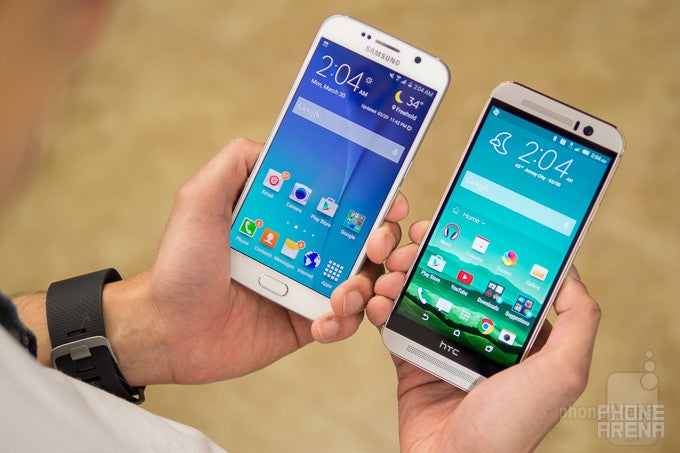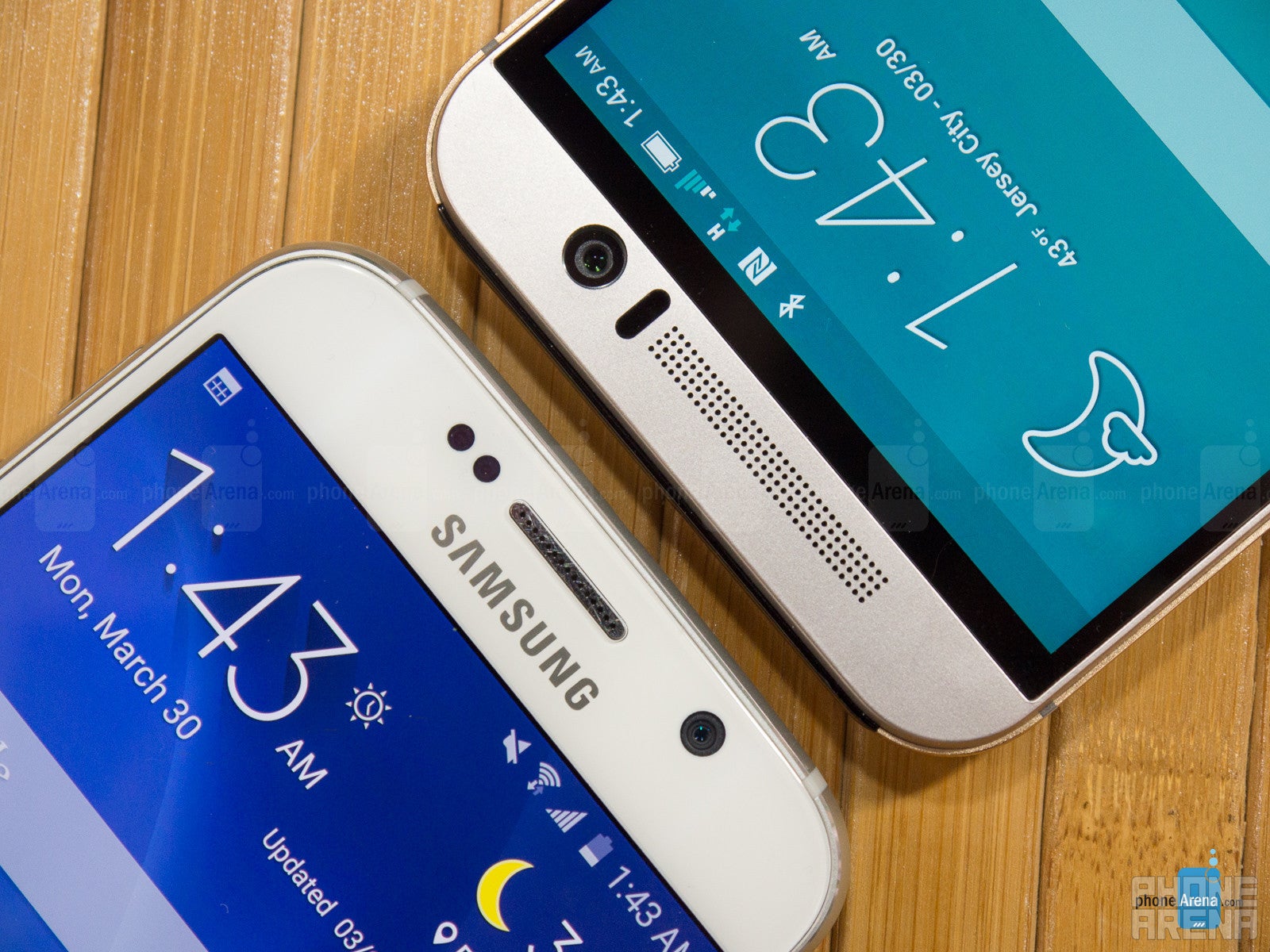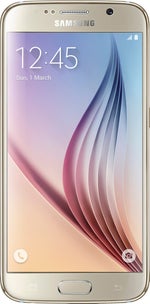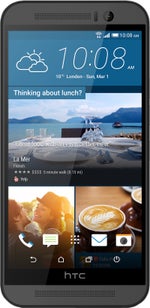Samsung Galaxy S6 vs HTC One M9

Introduction
We're starting out 2015 with a bang. The time for deliberation is over, and both Samsung and HTC are about to pounce on the market, hoping to slash as big a share as possible. But if your current daily driver is starting to feel a bit dated, and ready for an upgrade, it'll be up to you to pick between the two teams, and that's hardly ever a trivial task with high-end devices.
With the Galaxy S6, Samsung is impressing upon the public that it is both capable and willing to change if its fan base (and stock holders) requires it to. To that end, the Galaxy S6 comes in an unmistakably premium unibody that fuses glass and metal together. Better yet, Samsung has finally addressed complaints relating to its heavy TouchWiz overlay, with a number of optimizations having been carried out. All of this is rounded off with some truly bleeding edge hardware having found its way under the screen.
On the face of it, HTC's efforts fade in comparison, as despite its One M9 still commanding a respectable lead in terms of craftsmanship and overall design, the company has focused most of its attention on one single area: the rear camera. Indeed, gone is the under-performing UltraPixel camera, and we're now looking at a more impressive, 20-megapixel unit that the company hopes will position its flagship better than ever before.
So which one is the better buy? Let's dig in and find out.
Design
Sexier-than-ever-before the Galaxy S6 may be, but the One M9 remains the more stylish pick of the two.
With every new Galaxy S release, Samsung has historically built upon the base by refining what's already there and adding some extra on top. With the Galaxy S6, however, the electronics giant has focused far more on the latter than on the former. To that end, instead of the plasticky shell of the Galaxy S5, Samsung has adopted a metal frame that hugs the device all over and nestles within two sheets of Corning Gorilla Glass 4 – one placed in front of the display, and the other to protect the rear. Samsung didn't stop there, instead opting to carve several 'nano layers' into the shell. The result is a front and back that reflect light in different hues depending on your viewing angle. As it comes down to taste, this can be viewed as either ostentatious and tacky or unique and attractive. Regardless of which group you fall in, it's quite likely that you will not appreciate the ease with which the rear smudges – just a few minutes with the phone leaves the back a complete mess.
However, for all of Samsung's admirable efforts, and despite the undeniably sexier-than-ever-before appearances of the Galaxy S6, the One M9 still remains the more stylish pick of the two in our eyes. What could spell trouble for HTC's new flagship in the eyes of others, however, is the lack of visible changes. Indeed, despite its enjoyable looks, the One M9 remains a very similar device to its predecessor, the One M8, which, in turn, felt a lot like the One M7 before it. We certainly understand that the One line's design can be seen as timeless, but we nevertheless can't shake the feeling that we're looking at only a slightly redesigned device compared to last year's offering.
In terms of physical footprint and ergonomics, we've got a slight advantage for the Galaxy S6 on the first count, and a lead for the One M9 on the second. That is, while the S6 touts a slightly larger display, its dimensions of 5.65 x 2.78 x 0.27 inches still read a tad better than the M9's 5.69 x 2.74 x 0.38 inches, and specifically in terms of thinness. But a slim profile doesn't equal better handling, and that remains strictly an HTC domain. Indeed, the heftier depth to the M9 and the rounded rear shell make for a more ergonomic grip.
Display
In 'Basic' screen mode, the Galaxy S6's panel proves far superior to the one of the One M9.
The Galaxy S6 and One M9 both stick to the same display sizes introduced by their predecessors, but the two still differ vastly. With its new flagship, HTC is again making use of an S-LCD3 panel with a 5-inch diagonal and 1080 x 1920 resolution – good for 441 pixels per inch. In Samsung's camp, we're looking at a 5.1-inch Super AMOLED display, but unlike the one embedded within the S6's predecessor, we now have the whopping 1440 x 2560 pixels, or an even greater pitch of 577 ppi. Regardless, do keep in mind that due to the small physical size of these screens, that supposed advantage in pixel density is almost entirely limited to bragging rights on paper.
Speaking of what's on paper and what's going on in reality, let's talk about color calibration. With the Samsung Galaxy S6 set in the non-default Basic display mode, we're looking at a spot-on color temperature of 6550K (6500K being the desired optimal value), while the One M9 offers the unsatisfactory 8100K. In real terms, this means that the One M9's display is cold (or bluish) and that's especially visible with whites and various shades of gray. In comparison, Samsung's device offers realistic whites that are... well, white!
Were we to draw the line right here, the One M9 would only suffer a small defeat, instead of being steamrolled as it is in reality. Indeed, the Galaxy S6's display also proves far better in terms of color accuracy, with essentially every shade hitting its desired target at every intensity level, while the M9 falters significantly in comparison – reds are not quite red enough, yellows exhibit a greenish hue, and magenta leans heavily on blue. Further still, the S6 has an advantage in terms of maximum brightness – 563 nits vs the still excellent 508 nits for the One M9. It's only when talking gamma that the One M9 gets some relief – we measured 2.21, which is spot-on, while the S6 returned a slightly worse 2.11.
Interface and functionality
While the One M9's Sense 7.0 interface still is the fancier-looking of the two, Samsung has made incredible progress in terms of the smoothness of its own TouchWiz layout.
While Samsung's Galaxy S devices have always shipped with nothing less than the best available at the time in terms of hardware, we've often found ourselves wishing it did more on the software side. Its proprietary TouchWiz layout has often proved sluggish and less responsive than what some competitors had to offer – a slight that the Samsung faithful only tolerated because of the smorgasbord of extra features the platform gave them access to. With the Galaxy S6, however, the company has finally seen sense, and has carried out a number of software optimizations that make the Galaxy S6's software both easier to understand and faster than ever before.
Indeed, this is the first time that we can call the Android Lollipop-based TouchWiz experience truly smooth and hassle-free. But even though the company has cut down on the weight of its interface, the HTC One M9's refreshed Sense 7.0 UI is just as fast. What's more, and while we can't argue with people's differing tastes, we still find the brushwork of Sense 7.0 more appealing from where we're standing. The One M9, however, simply can't compete in the features department.
Quite right, the One M9's software reminds us a lot of stock Android, as HTC continues sticking to the basics and adds little on top. The interface looks differently, sure, but at its base is Android the way Google intended it. And while the updated, Lollipop-based Sense 7.0 layout brings goodies such as dynamic app folders that automatically switch their contents depending on whether you're working or at home, and can now be thoroughly skinned via the new Themes app (think icons, wallpapers, styling and ornamentation), it still doesn't compare to what Samsung offers.
With the new TouchWiz, Samsung is keeping a lot (but not all!) of the perks that made it unique, and refreshing or even completely re-designing areas that it wasn't completely satisfied with. For example, the S Health app has gone through a revamp and is now minimalist- and modern-looking while retaining the same wide array of functions. Like HTC, Samsung has also added support for third-party themes, and its own Themes app already offers a number of solutions, though none of them really caught our eye – for that, we'll have to wait and hope third-party devs feel incentivized enough to create something beautiful.
The Galaxy S6's stack of features is hardly exhausted yet, for we also have a new, improved fingerprint scanner (still embedded in the physical Home button) that is now of the touch, not swipe, type, finally allowing for a hassle-free unlock. Unlike the One M9, the S6 also offers software features like MultiWindow (run two apps simultaneously), and Private and Car modes (hide sensitive content / dashboard with bigger icons and essential apps only).
Processor and memory
While the Galaxy S6's Exynos chipset proves a great alternative to the Snapdragon 810 in the One M9, it's Samsung's incredibly fast new storage solutions that gives it an edge over its competitor.
For the longest time, Samsung and Qualcomm worked together on the former's flagship lines, though the chip maker didn't always get all the orders – the rest went to Samsung's then fledgling semiconductor division making the Exynos chipsets. With the Galaxy S6, however, Samsung was ready for a monumental shift, and Qualcomm is no longer part of the game. Instead, the S6 relies on a home-grown Exynos 7420.
The 7420 is an octa-core processor, built on a 14nm node, with two clusters made up by four cores arranged in a big.LITTLE configuration and Mali-T760 graphics. We have one group of power-efficient ARM Cortex-A53 CPUs, and another with powerful Cortex-A57 ones. The idea behind the arrangement is simple to understand – the efficient team of cores takes care of most trivial tasks, while the speedy A57 cores kick in when power is required. If maximum performance is what you need, the Exynos 7420 can switch all eight cores on and work them simultaneously.
Turning to the HTC One M9, we're seeing the chipset that Samsung deemed inferior to its own – the 20nm, octa-core Snapdragon 810. Qualcomm's latest available creation is quite similar to Samsung's, for it, too, offers the same four-by-four ARM Cortex-A53/A57 cores under a big.LITTLE config, the difference being the Adreno 430 GPU.
According to benchmarks, the Galaxy S6 has an edge in terms of processing power and memory, but falls behind the One M9 when graphics tests get involved. Indeed, the One M9's Adreno 430 GPU handles heavy loads in those scenarios better, achieving average frame rate values that are significantly higher than those of the Mali-T760. In general, however, using either of the two devices proves buttery smooth.
As for memory, we have 3 gigs of LPDDR4 RAM with both flagships, and a minimum of 32GB of internal storage. Speaking of the last, and we already touched on this, Samsung is utilizing what is without a doubt the fastest internal memory we've seen so far – a mix between eMMC 5.1 and UFS 2.0 – which offers a vastly superior performance than anything we've seen to this date. That said, if you value storage expandability, the S6 will leave you hanging – for the first time ever, a Galaxy S line flagship comes without a microSD card slot, giving the advantage to the One M9, which does.
Internet and connectivity
All your needs will be met regardless of which way you go.
Smooth browsing is what we've been getting with each and every flagship for the past few years, and Samsung's and HTC's new offerings don't fail to deliver just that. Courtesy of their powerful internals, both devices handle even asset-heavy pages with ease and don't struggle when navigating through them. That said, whereas both devices rely on Chrome for your browsing needs, Samsung's Galaxy S6 comes with its own default solution that is an equally great performer.
On the connectivity front, you'll hardly find much to complain about, regardless of whether you go for the Galaxy S6 or the One M9. Both devices offer support for a wide array of LTE bands, 5GHz Wi-Fi, Bluetooth 4.1, NFC, DLNA, MHL 3.0 for streaming up to 4K resolution content to a secondary screen, an infrared blaster for control over home electronics, and even Miracast in the case of the S6.
Where the Galaxy S6 pulls ahead is Samsung Pay – the company's new mobile payments solution that works hand-in-hand with the handset's NFC chip. The idea behind it is much alike to that of Apple Pay – the company gets retailers and banks involved (but free of charge), and you reap the benefit of never having to pull out your credit card out of your wallet again (much less physically sign any receipts).
Camera
HTC's supposed savior, the 20-megapixel camera of the One M9, is no match for what the Galaxy S6 has in store.
Samsung's Galaxy S line has always been synonymous with great camera quality, and the company wasn't about to drop the ball with the Galaxy S6. Instead of focusing on the software side of performance, Samsung has taken a two-pronged approach by making sure to deliver some exciting hardware updates, too. To that end, the Galaxy S6's 1/2.6”, 16-megapixel rear camera comes with a wider-than-before f/1.9 aperture lens and an optical stabilization gizmo attached to it. The selfie snapper, too, has received a commendable update, and now offers 5-megapixels of resolution and an equally wide, f/1.9 aperture lens.
We have reasons for excitement when it comes to the HTC One M9, too, for the company has finally made the decision to ditch the 4-megapixel UltraPixel camera of old, which has been relegated to selfie service. At the back, we're now looking at a 1/2.4”, 20-megapixel sensor with relatively narrower, f/2.2 lens and a dual LED flash.
Software wise, we've got to say that we're witnessing a small miracle – HTC's, not Samsung's, camera app is the more feature-filled. We've got a ton of shooting modes, including panorama, night, HDR, and bokeh, not to mention numerous photo-editing goodies built right in. With the Galaxy S6, we've got a re-designed, lighter camera interface that is easier on the eyes and snappier in its performance. The number of shooting modes has been brought down, too, but we still have the likes of panorama, HDR, Selective Focus, Virtual Shot, and a new Pro mode that gives you access to manual controls such as ISO, white balance, exposure correction, and focus. Another seemingly simple, but quite effective, feature – exactly the type we love – also can't be glossed over. More specifically, the Galaxy S6's physical home button can now be pressed twice in order to almost instantaneously enter the camera, regardless of what you're doing at the time.
So let's talk image quality. Starting with daytime snaps taken outdoors, as with most high-end smartphone cameras, there's little to complain about. Both the One M9 and the Galaxy S6 produce very decent photos, and neither can be said to visibly outdo the other. They differ though. For example, the One M9 takes slightly brighter photos in general, much of that owed to a more aggressive ISO tweaking. On the other hand, the Galaxy S6 produces a bit more compelling-looking images, with warmer tones.
Indoors, however, we're looking at quite different a match-up. Unfortunately for HTC, the One M9's camera simply can't compare, as even before we have to point out the obvious color inaccuracies and far more severe noise levels inherent to the stills it produces, we have already called it a loss. That is for a reason – the software algorithms governing the camera push the shutter speed way low, likely in hopes of producing a sufficiently bright photo, but that comes at the terrible cost of blur – an issue the S6 does not suffer from.
The struggle is similarly one-sided when it comes to nighttime and low light performance. The Galaxy S6 fares considerably better, bringing us far brighter and more representative photos that offer more detail at the cost of much less noise. Indeed, in order to produce even barely passable night stills, the One M9 cranks up the ISO to 1600, and still fails to let us see much of the scene.
The One M9 gets no reprieve in terms of video, either, for its footage proves softer, less detailed, and a whole lot shakier than the Galaxy S6's. That last part is obviously the work of the optical stabilization gizmo on board Samsung's flagship, as it does a splendid job compensating for trembles and shake in your hands.
In conclusion, we'd be remiss if we didn't make one thing perfectly clear: if camera performance is your number one priority, the Galaxy S6 is the clear choice between these two new flagships.
Multimedia
If you stellar audio is what you seek, the One M9 is the no-brainer choice here.
On the multimedia front, we have a few interesting developments. For starters, much like with the rest of the interface, Samsung has toned down the over-the-top rhetoric, and is now treating us to far cleaner visuals when it comes to essentials such as the Music player and the Gallery. In comparison, HTC's solution feels markedly premium, and we have to admit that we tend to like the brushwork better. Interestingly enough, this is another area in which Samsung's implementation proves slightly less feature-rich than HTC's – something we wouldn't dream of just two years ago.
Going back to music, if you happen to enjoy using your device as a portable speaker, then you'll enjoy what the One M9 has to offer more. Sure, we measured a slightly higher volume coming out of the S6's loudspeaker (73.7 dB vs 72.8 dB), but the differences are small enough to be nigh impossible for us to really tell. More importantly, the stereo front-facing blasters of the One M9 produce richer and more immersive tones, whereas the bottom-placed grill of the S6 lets out more subdued and thin sounds.
If you, instead, mostly use your smartphone with a pair headphones (as most people do), then it's even more clear-cut for you – the One M9 offers the astounding 1.022 Volts of power, while the Galaxy S6 proves a distant second, with just 0.54 Volts going through its 3.5mm jack.
Call quality

The same can be said for the performance of the two loudspeakers – you can hold call with both, but while the Galaxy S6 mostly banks on being loud enough so that a call can be comfortably held, the One M9 tops that with both volume and better sound clarity.
Battery life

In reality, these capacities translate into battery endurance in a way you wouldn't expect, especially since the M9 has a bigger battery and a far less pixel-dense display. Indeed, while the Galaxy S6 manages the very decent 7 hours and 14 minutes on our custom battery life test, the One M9 is average at best, with a score of just 6 hours and 25 minutes.
Conclusion
If you've ever struggled picking between two great flagships in the past, you'll likely know what we ourselves understand all too well – when you're looking to make the most out of your hard-earned cash, choosing can be difficult. Fortunately, with the Samsung Galaxy S6 and the HTC One M9, things are clear-cut enough for you to simply have to identify what's important to you personally – the answer will then come to you naturally.
So, do you value camera performance and battery life above all else? The Galaxy S6, then, is the obvious choice – it steamrolls the One M9's unsatisfying, 20-megapixel shooter, and manages almost an hour longer on our battery life test. It also has the slightly larger display, which is notably superior to its competitor's solution when set to 'Basic' mode.
Are you more intrigued by the design work that goes into your gadget? Is sound quality an overly important consideration for you? And are you annoyed by software gimmicks? If you mentally noted a 'yes' whilst going through those three questions, then your choice is simple, and its name is HTC One M9. Indeed, while Samsung has spent a considerable amount of effort trying to classy up the Galaxy S6, the M9's full aluminum body is uncompromisingly beautiful, and comes with none of the oily mess that is the S6's back. What's more, the One M9 is a superior platform for listening to music – whether you go wired or not.
Ultimately, point-for-point, the Galaxy S6 is the superior device of the two. But it's not the classier – a subtle, but important difference.

Samsung Galaxy S6
Pros
- Considerably thinner and lighter
- Has a more color-correct display in 'Basic' mode
- Offers a more feature-rich experience
- Speedier internal flash storage
- Markedly better camera, especially in low light
HTC One M9
Pros
- Arguably the classier phone
- Has a more streamlined interface
- Handles graphics-intensive benchmarks better
- Superior, stereo front-facing speakers
- Better call quality


























Things that are NOT allowed: